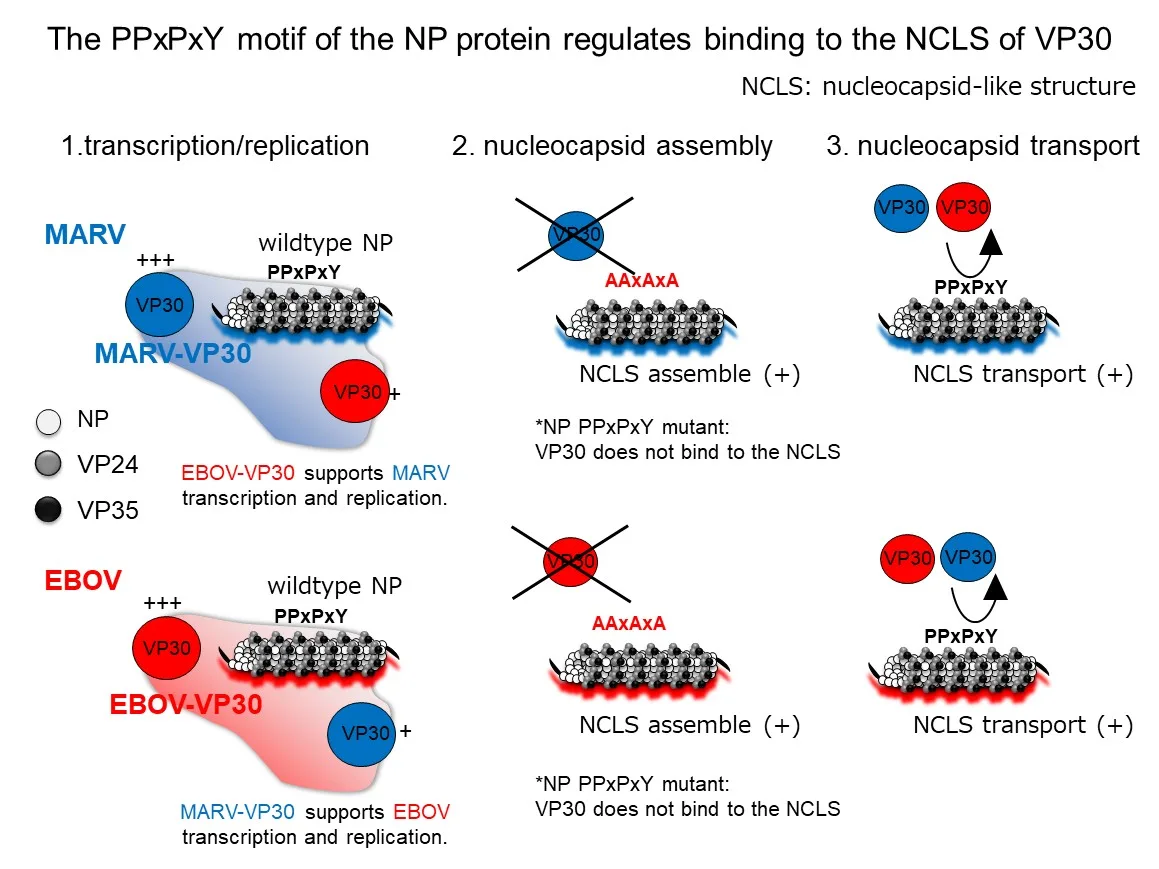

Discovery of a Common Target in Nucleocapsid Formation of Ebola and Marburg Viruses—Potential for Developing New Antiviral Drugs
Professor Yuki Takamatsu of the Department of Virology, Institute of Tropical Medicine, Nagasaki University, Professor Takeshi Noda of Laboratory of Ultrastructural Virology, Institute for Life and Medical Sciences, Kyoto University, and their research group used advanced live-cell imaging to study the assembly and transport mechanisms of filoviruses (Ebola and Marburg viruses). Their findings were published in the international journal mBio.
Ebola virus (EBOV) and Marburg virus (MARV) belong to the Filoviridae family and cause fatal hemorrhagic fever in humans and other primates. Although outbreaks continue to occur in Central and West Africa in recent years, there are currently limited available treatments for these viruses.
The nucleocapsid of filoviruses consists of a helical complex of genomic RNA and viral proteins, which is responsible for transcription and replication of the viral genome.
In this study, we used advanced live-cell imaging techniques to elucidate the molecular mechanisms involved in nucleocapsid formation of Ebola virus (EBOV) and Marburg virus (MARV). We found that the viral protein VP30, known as a transcription regulating factor, functions together with the nucleocapsid and exhibits transcription and replication activity even when exchanged between the two viruses.
Furthermore, we revealed that the PPxPxY motif located at the C-terminus of NP protein in both viruses is essential for the interaction between NP and VP30, highlighting the importance of VP30 in nucleocapsid assembly. Since this motif is conserved among filoviruses, it suggests a potential target for the development of novel antiviral drugs.
Our findings provide significant insights into the mechanisms of nucleocapsid formation in filoviruses and contribute to the development of new therapeutic strategies against filovirus infections.

Role of the PPxPxY motif of NP during NCLS assembly in MARV and EBOV. This figure illustrates the current understanding of NCLS assembly and VP30-NCLS associations across three key processes: (1) viral genome transcription/replication, (2) nucleocapsid assembly, and (3) nucleocapsid transport. (1) In filoviruses, NP forms perinuclear inclusions, where viral genome transcription/replication and nucleocapsid synthesis occur. VP30 co-localizes with heterologous NP-forming inclusions and partially restores heterologous minigenome transcription/replication. (2) Mutations in the PPxPxY motif regulate NP-VP30 interactions in both MARV and EBOV. (3) VP30 is associated with heterologous NP, facilitating its linkage to NCLS. This indicates that NCLS is initially formed by NP, VP35, and VP24, with VP30 association occurring during or after NCLS assembly.
Journal: mBio
Title: Molecular insights into nucleocapsid assembly and transport in Marburg and Ebola viruses
Authors:
Yuki Takamatsu
Department of Virology, Institute of Tropical Medicine, Nagasaki University (ITM-NU)
Graduate School of Biomedical Sciences, Nagasaki University
Olga Dolnik
Institut für Virologie, Philipps-Universität Marburg
Ai Hirabayashi
Laboratory of Ultrastructural Virology, Institute for Life and Medical Sciences, Kyoto University
Kenta Okamoto
Program of Molecular Biophysics, Department of Cell and Molecular Biology (ICM), Uppsala University
Tomomi Kurashige
Department of Virology, Institute of Tropical Medicine, Nagasaki University (ITM-NU)
Hu Shangfan
Department of Virology, Institute of Tropical Medicine, Nagasaki University (ITM-NU)
Catarina Oda Harumi
Department of Virology, Institute of Tropical Medicine, Nagasaki University (ITM-NU)
School of Tropical Medicine and Global Health (TMGH), Nagasaki University
Takeshi Noda
Laboratory of Ultrastructural Virology, Institute for Life and Medical Sciences, Kyoto University
Laboratory of Ultrastructural Virology, Graduate School of Biostudies, Kyoto University
Corresponding Author:
Yuki Takamatsu (https://orcid.org/0009-0008-6706-438X)
For more details, please see the full article published in mBio.